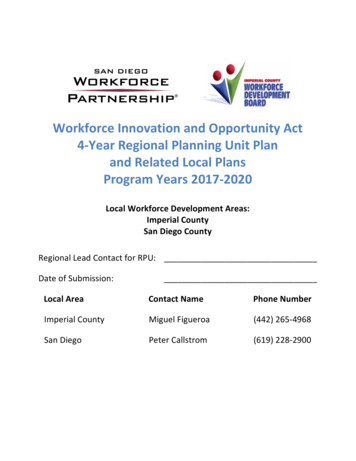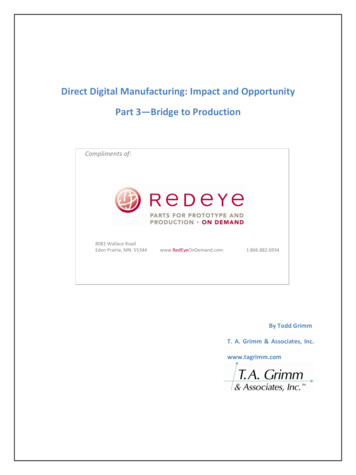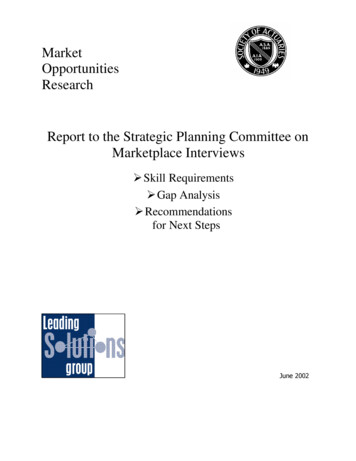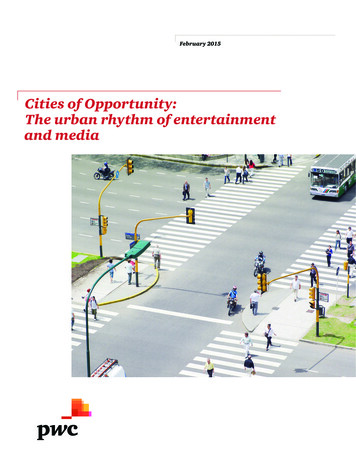
Transcription
Workforce Innovation and Opportunity Act4-Year Regional Planning Unit Planand Related Local PlansProgram Years 2017-2020Local Workforce Development Areas:Imperial CountySan Diego CountyRegional Lead Contact for RPU:Date of Submission:Local AreaContact NamePhone NumberImperial CountyMiguel Figueroa(442) 265-4968San DiegoPeter Callstrom(619) 228-2900Table of Contents
List of Regional Partners Who Are Party to the Plan3Economic and Background Analysis6Regional Sector Pathways16Industry-Valued Post-Secondary Credential Attainment27Accessibility and Inclusivity29Job Quality Considerations33Regional Assessment37Federal Requirements38Appendices392
Executive SummaryThe Southern Border region is at the forefront of economic trade and cultural merging in America, due toits location along the border with Mexico. The opportunity of the region exists in its focus onentrepreneurship and its strong urban anchor to the west, San Diego. The largely rural communities to theeast of that anchor city, in Imperial County, are working to develop the sustainable economic growth thathas existed in San Diego in recent years.The workforce development system in the Border Region began coordination and alignment efforts inrecent years, with the goals of supporting the businesses of the region and to ensure that every person hasthe skills to ensure a sustainable career. In that regard, we support the State Plan’s overarching goals ofone million more industry-recognized credentials in the next 10 years, and doubling the amount ofapprentices in the same time span. This Regional Plan aligns our efforts to achieving those goals, not onlyamong the participating Workforce Development Boards, but all of the partners in the region’s workforcedevelopment system.The Southern Border region’s Regional Plan was developed from a core document that was designed to beshared by both the Workforce Development Boards for the WIOA Regional Plan, as well as the CommunityCollege system for their Strong Workforce Regional Report. This type of collaboration is a hallmark of thework in our region. The development of that core document incorporated many regional partners,including: The ten community colleges and six community college districts in the region, The San Diego andImperial County Workforce Development Boards, K–12 and adult education, universities, economicdevelopment entities, Employment Development Department LMID, CalWorks, County of San Diego,Department of Rehabilitation (DOR), and community organizations from throughout the two-countyregion.This collaborative determined three strategic priorities, which will be discussed in-depth in the plan. Thesepriorities are: Strategic priority #1: Coordinating industry engagement and developing a single entry point forbusiness customers Strategic priority #2: Creating opportunity for all San Diego and Imperial County residentsthrough career pathway development Strategic priority #3: Supporting human-centered approach to service designThese strategic priorities will be at the center of planning for the region’s workforce development system,and align well with the priorities of the Unified Workforce Development Plan for the State of California.3
List of Regional Partners Who Are Party to the PlanDescribe the geographic boundaries of the Regional Planning Unit and any plans to petition for aregional planning partner modification.The region is the southernmost region in California. Surrounding counties include Orange and Riversidecounties to the north. The Colorado River forms the eastern boundary of Imperial County and the ArizonaCalifornia border. The region enjoys seventy miles of Pacific Ocean coastline, and shares its southernborder with the country of Mexico. The major east-west thoroughfare is Interstate 8, which begins in SanDiego and travels east to Arizona. State routes 78 and 111 also figure prominently in the county’stransportation system.List the regional partners who are party to the plan and describe their role in developing andimplementing the regional plan.The Southern Border Regional Workforce Development Plan Committee first met in June of 2016. Thefollowing organizations had representatives that attended one or more of the following regional feedbackand planning sessions:1.2.3.4.5.Formation meeting in May, 2016Initial meeting in June, 2016Partner meeting in September, 2016San Diego Workforce Partnership’s Workforce Conference in November, 2016Assessment meeting in November, 2016Ten community colleges (six districts) in the region Cuyamaca College Grossmont College Imperial Valley College MiraCosta College Palomar College San Diego City College San Diego Continuing Education San Diego Mesa College San Diego Miramar College Southwestern CollegeSan Diego and Imperial Workforce Development Boards San Diego Workforce Partnership (SDWP) Imperial County Workforce Development Office (ICWDO)4
K–12 (secondary) and adult education San Diego County Office of Education Poway Unified School District (more districts represented — Poway represented on the PlanningCommittee, check sign-in sheet for November 7) Imperial County Office of Education San Diego-Imperial Adult Education ConsortiaUniversities University of California, San Diego (UCSD) Extension San Diego State University (SDSU)Industry/Industry Association/Regional Government/Economic Development/Chambers East County Economic Development Council Imperial Valley Economic Development Corporation (IVEDC) San Diego Regional Economic Development Corporation San Diego Association of Governments (SANDAG)Other Employment Development Department LMIDCalWorksCounty of San DiegoDepartment of Rehabilitation (DOR)In addition, the region contacted community-based organizations through the California WorkforceAssociation (CWA) to ensure that they were informed on the planning process. This contact culminated ina statewide webinar that described the regional and local planning processes in detail, with an invitation toparticipate in the planning process in the region.In all, 100 individuals serving these populations were contacted, including but not limited to: Next Gen ClimateCalifornia Immigrant Policy CenterThe Alliance for Language Learners Integration, Education and SuccessCAASoutheast Asia Resource Action CenterAsian Resources Inc.World Relief5
Regional Economic and Background AnalysisProvide a regional analysis of economic conditions including existing and emerging in-demand industrysectors and occupations, and employment needs of employers in existing and emerging in-demandindustry sectors and occupations. A local area may use an existing analysis, which is a timely currentdescription of the regional economy, to meet the foregoing requirements.Top Demand Industry Sub SectorTotal Projected JobOpenings 2012–2022Restaurants and Other Eating PlacesElementary and Secondary SchoolsManagement, Scientific, and Technical ConsultingColleges, Universities, and Professional SchoolsIndividual and Family ServicesTraveler AccommodationEmployment ServicesOffices of PhysiciansScientific Research and Development ServicesComputer Systems Design and Related ServicesTop Emergent Industry Sub ,08911,52911,431Numeric Change2012–2022Management, Scientific, Tech ConsultingServicesBeer, Wine, Distilled Alcoholic BeverageWholesalersWired Telecommunications 4,4703,0002,340730Technical and Trade SchoolsOther General Merchandise StoresWholesale Electronic Markets and Agents andBrokersResidential Building ConstructionAmusement Parks and ArcadesNondepository Credit IntermediationBusiness Schools, Computer/Mgmt 58.60%57.50%56.50%Source: Employment Development Department, Labor Market Information Division.The San Diego Workforce Partnership (SDWP) and community colleges in the region represented by theSan Diego and Imperial Counties Community Colleges Association (SDICCCA) initiated and implementedregional collaboration over the past three years to conduct research and produce studies with actionablefindings for the region. These studies represent the first step in cooperative, sector-based strategies forworkforce development. Together, regional partners conducted online surveys, in-person interviews andfocus groups of regional employers from five priority sectors and collaborated on several additional sectorstudies.These reports are listed in Appendix A: Advanced Manufacturingo6Aerospace
o Blue TechClean Energyo Advanced Transportationo Aircrafto Automotive/MotorcycleInformation & CommunicationTechnologiesHealth CareLife Sciences Small BusinessSpecialty Foods & MicrobreweriesGlobal Trade & LogisticsWorkforce Initiatives in the PrioritySectorsMiddle-skill JobsApprenticeshipsRetailGig EconomyComprehensive interviews and surveys of thousands of employers in the region gave the region an insightinto the jobs that can be filled with an associate degree or postsecondary certificate. Our findings andrecommendations paint a picture of today’s labor market needs and potential shortages of trainedworkforce.Provide an analysis of the knowledge and skills needed to meet the employment needs of the employersin the region, including employment needs in in-demand industry sectors and occupations.Middle-skill Workforce NeedsRegional partners have conducted an analysis of the projected demand for middle-skill occupations andavailable supply of trained workers (Appendix C). The analysis of showed an undersupply of workers in theregion in the following occupational groups: Office and administrative support Health care practitioners and technical occupations (San Diego only) Sales and related Installation, maintenance and repair Construction and extraction Production (San Diego only) Transportation & material moving Life, physical and social science (San Diego only) Community and social services Legal (San Diego only) Health care support Personal care and service Education, training and library Food preparation and serving (Imperial only)Cross-sector Employer NeedsUtilizing the findings from multiple sector studies, regional partners established several cross-sectoremployer needs/priorities:1. Workers with strong soft skills are essential for businesses to succeed. The number one skillrequested by employers across all sectors are the soft skills — communication, professionalism,7
2.3.4.5.6.critical thinking, problem-solving, etc. Communication, both written and spoken (advanced manufacturing) Teamwork, customer service, problem-solving and critical thinking (health care) Basic work skills such as basic computer skills, ability to read a tape measure, andworkplace readiness (advanced manufacturing, clean energy, global trade)Soft skills make the difference in securing and retaining employment. Like the point above, if ajob candidate can prove their soft skills to an employer, they have a much higher likelihood ofretaining employment. Communication, writing, troubleshooting, problem-solving and critical thinking (advancedmanufacturing) Teamwork, customer skills, time management, written and oral communication, problemsolving, and job-readiness skills (health care) Project management, flexibility, relationship building, listening, critical thinking (ICT/digitalmedia)Previous work experience is key for many well-paying middle-skill occupations. Previous workexperience offers a lot of insight to employers without even meeting a candidate. It shows that thecandidate has both technical and soft skills required for the position, as they have successfully helda previous position. Work experience gives a leg up when the competition is tight for a position. Allied health occupations — employers seeks candidates with at least one year of clinicalexperience 57% of biotech employers are having difficulty finding experienced workers Employers across sectors report the need for more experienced workforceTechnical skills are required to respond to the latest innovations and technological changes. Witha quickly changing technologic world, it is important for workers to keep up with new technologiesfor companies to remain competitive in the economy. Communication, writing, troubleshooting, problem-solving and critical thinking (advancedmanufacturing) Teamwork, customer skills, time management, written and oral communication, problemsolving, and job-readiness skills (health care) Project management, flexibility, relationship building, listening, critical thinking (ICT/digitalmedia)Industry-based certifications are an indicator to employers of a job candidate’s technicalproficiency. Certifications are a great way for employers to know right off the bat what skills anindividual possesses. Many certifications are approved through the state of California, resulting ina state-wide comprehension of those individuals who possess a certain certificate. Phlebotomy, animal laboratory certification (life sciences/biotech) Microsoft, Cisco, CompTIA (ICT/digital media) Automotive Service Excellence Certification (advanced transportation)Regional employers have difficulties finding qualified employees and are interested in new waysto find and cultivate new talent. This is especially true for small businesses who may not have ahuman resources department or professional. Employers do not have a lot of time to search for8
the perfect candidate and are open to new ideas for finding job candidates. Businesses have a strong interest in partnering with the community colleges forinternships and company tours (advanced manufacturing) Companies are seeking workers who have strong technical skills and hands-on experience Employers are interested in hiring and promoting from within, creating strong careerpathways inside a single company, providing opportunity for training incumbent workers(advanced transportation)7. Small businesses have few jobs posted online, and instead rely on word-of-mouth to hire newemployees. While most aspects of business have moved online, the job market is still a low-techarea. Instead of hiring an unknown individual based on a resume and interview, employers canutilize existing employees for referrals, which may be more reliable for finding new workers. Networking is essential to finding these small-business jobs (all sectors) Improved collaboration between community colleges and businesses to conduct jobplacement and ensure training programs focus on the in-demand skills (advancedmanufacturing, health care)8. Imperial County’s economy is strongly tied to the border region and cross-border trade withMexico. Imperial County’s economy, while tied to San Diego County, is very strong in cross-borderrelations, due to the proximity to Mexico. This creates a unique opportunity in the area forinnovative solutions. Logistics, supply chain management (global trade) Entry-level jobs that could be filled by graduates of community college programs (shipping,receiving and traffic clerks) (global trade, advanced manufacturing) Manufacturing occupations at companies whose product is sold globally (advancedmanufacturing)9. Many students are completing programs/graduating with degrees; however, the quality of thelabor supply is unknown — this is an area for further evaluation and study. The Priority SectorInitiatives report compiles nearly 500 workforce initiatives, including hundreds of education andtraining programs; however, their effectiveness can be studied to determine if training gaps have,in fact, been addressed by the initiatives, or if program improvement or new programs arenecessary to fill those gaps.Provide an analysis of the regional workforce, including current labor force employment andunemployment data, information on labor market trends, and educational and skill levels of theworkforce, including individuals with barriers to employment.The labor force in the two-county region has shrunk as employment has increased, giving the region ahealthy 4.9% unemployment rate as a whole.The two-county region does not have a large outflow-inflowdeficit in terms of commute traffic, with a net outflow that amounts to 2.1% of the total employedpopulation in the region.The two counties do have a large variance in median household income, with SanDiego County households generating about 64,000 and Imperial County households generating over 22,000 less per year.9
Labor Market ProfileLabor ForceEmployedUnemployedUnemployment RateMay 20161,635,9001,555,40080,4004.9%May 17,300-1.0%Percent-0.6%0.5%-17.7%-Source: Employment Development Department, Labor Market Information Division.Data Note: Numbers may not add up due to rounding.The Hispanic/Latino community comprises 35.2% of the population of the two-county region.The region’sdiversity also includes 7.1% Black/African-American, 0.6% American Indian, 16.3% Asian, 0.6% NativeHawaiian/Pacific Islander, and 4.9% Other/Two Race population. Of the total population, 23.8% areforeign-born, and 16.7% are classified as speaking English “less than very well.” Veterans and individualswith disabilities also comprise large segments of the two-county region’s population, with veteranstotaling 7.2% and individuals with disabilities at 9.7%.Ensuring the prosperity of the families that comprise these communities is not only good policy, it isessential to maintaining a robust economic engine in the two-county region.The workforce boards andtheir partners have made equity in access to these services one of their key priorities, as discussed later.The subsets of individuals with barriers to employment listed above require specialized services that aretargeted to their specific barriers. The America's Job Center of California system in San Diego and Imperialcounties, along with their community college partners, are developing a customer-centered approach toserving these populations that will be discussed in depth later in the plan.Individuals with Barriers to EmploymentEthnic minoritiesHouseholds with cash public assistance or food stampsPopulation 18 and over with less than a 9th grade level educationSingle-parent householdsSpeak English less than “very well”Youth ages 10 to 24Educational Attainment, 25 Years and 21Total334,296419,691692,985747,1502,194,122Less than high school diplomaHigh school graduate (includes equivalency)Some college or associate’s degreeBachelor's degree or higherTotalSource: U.S. Census Bureau, 2010–2014 American Community Survey, 5-Year EstimatesOne significant barrier to employment in the region is the educational barriers faced across populations.The total number of otherwise-qualified individuals who have less than a high school diploma numbers334,296 persons, which amounts to 15.2% of the overall qualified population. This segment is largelydisadvantaged in the labor market, and must be given a pathway to education and industry-recognizedcertifications to raise their chances at economic success. These pathways will be discussed at length in this10
plan.Please see further demographic information, included in the Appendices at the end of this report.Provide an analysis of workforce development activities, including education and training, in the region.This analysis must include the strengths and weaknesses of workforce development activities andcapacity to provide the workforce development activities to address the education and skill needs of theworkforce, including individuals with barriers to employment, and the employment needs of employers.Based on the findings for each sector, SDWP created an inventory of all workforce-related programs andinitiatives and classified them by Priority Sector to determine where there were gaps between therecommendations for the research and the reality of the workforce development landscap
College system for their Strong Workforce Regional Report. This type of collaboration is a hallmark of the . Grossmont College Imperial Valley College MiraCosta College Palomar College San Diego City College . Phlebotomy, animal laboratory certification (li











